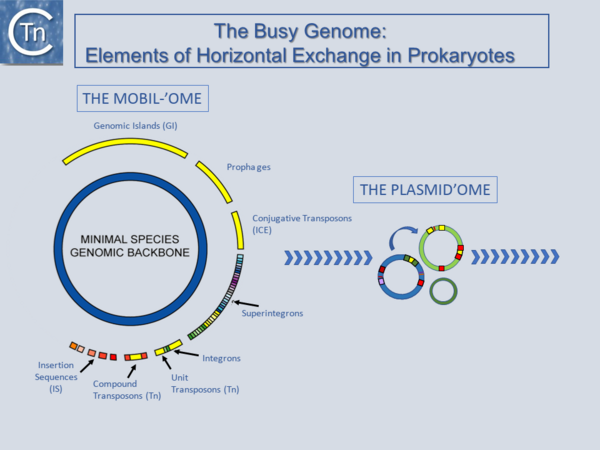Difference between revisions of "General Information/Overview"
| Line 11: | Line 11: | ||
<br/> | <br/> | ||
<hr> | <hr> | ||
| − | |||
Revision as of 13:45, 4 December 2022
The idea that many prokaryotic genomes are mosaic, composed of a "central genome backbone" of essential and house-keeping genes (the core genome) interspersed with DNA segments constituting the "mobilome" (a variety of accessory genes that form part of the pan-genome)(Fig.1.1), is now common currency [1][2]. The mobilome embraces several types of genetic units which, as their collective name indicates, can move from place to place in a particular genome or from cell to cell. These Mobile Genetic Elements (MGE) can be divided into two major groups: those, such as plasmids and bacteriophages, that are transmissible from cell to cell (the intercellular MGE), and those that cannot themselves undergo transfer but which are transferred following integration into members of the first group (the intracellular MGE).
Intracellular MGE or Transposable Elements (TE) include transposons (Tn) and Insertion Sequences (IS) but can embrace integrons (In) [3][4] and introns [5][6][7][8].
Originally Tn were distinguished from IS since they carry passenger (also called cargo) genes not involved in catalyzing or regulating TE movement. Most eukaryotic DNA transposons have relatives among the prokaryotic IS (see [9]) and it is not surprising that a variety of these elements carrying passenger genes are now also being identified [10][11].
Prokaryotes harbor a host of such elements as well as several types of structure possessing characteristics of both groups (e.g. Integrative Conjugative Elements (ICE), originally called conjugative transposons, as well as other types of non-conjunctive genomic islands) [12][13][14].

Bibliography
- ↑ Medini D, Donati C, Tettelin H, Masignani V, Rappuoli R . The microbial pan-genome. - Curr Opin Genet Dev: 2005 Dec, 15(6);589-94 [PubMed:16185861] [DOI]
- ↑ Tettelin H, Riley D, Cattuto C, Medini D . Comparative genomics: the bacterial pan-genome. - Curr Opin Microbiol: 2008 Oct, 11(5);472-7 [PubMed:19086349] [DOI]
- ↑ Escudero JA, Loot C, Nivina A, Mazel D . The Integron: Adaptation On Demand. - Microbiol Spectr: 2015 Apr, 3(2);MDNA3-0019-2014 [PubMed:26104695] [DOI]
- ↑ Escudero JA, Loot C, Parissi V, Nivina A, Bouchier C, Mazel D . Unmasking the ancestral activity of integron integrases reveals a smooth evolutionary transition during functional innovation. - Nat Commun: 2016 Mar 10, 7;10937 [PubMed:26961432] [DOI]
- ↑ Craig NL, Chandler M, Gellert M, Lambowitz A, Rice PA, Sandmeyer S. Mobile DNA III. 3rd ed. Washington, DC: ASM; 2015.
- ↑ Lambowitz AM, Belfort M . Mobile Bacterial Group II Introns at the Crux of Eukaryotic Evolution. - Microbiol Spectr: 2015 Feb, 3(1);MDNA3-0050-2014 [PubMed:26104554] [DOI]
- ↑ Zimmerly S, Semper C . Evolution of group II introns. - Mob DNA: 2015, 6;7 [PubMed:25960782] [DOI]
- ↑ Zimmerly S, Wu L . An Unexplored Diversity of Reverse Transcriptases in Bacteria. - Microbiol Spectr: 2015 Apr, 3(2);MDNA3-0058-2014 [PubMed:26104699] [DOI]
- ↑ Hickman AB, Chandler M, Dyda F . Integrating prokaryotes and eukaryotes: DNA transposases in light of structure. - Crit Rev Biochem Mol Biol: 2010 Feb, 45(1);50-69 [PubMed:20067338] [DOI]
- ↑ Bao W, Jurka MG, Kapitonov VV, Jurka J . New superfamilies of eukaryotic DNA transposons and their internal divisions. - Mol Biol Evol: 2009 May, 26(5);983-93 [PubMed:19174482] [DOI]
- ↑ Bao W, Jurka J . Homologues of bacterial TnpB_IS605 are widespread in diverse eukaryotic transposable elements. - Mob DNA: 2013 Apr 1, 4(1);12 [PubMed:23548000] [DOI]
- ↑ Burrus V, Waldor MK . Shaping bacterial genomes with integrative and conjugative elements. - Res Microbiol: 2004 Jun, 155(5);376-86 [PubMed:15207870] [DOI]
- ↑ Dobrindt U, Hochhut B, Hentschel U, Hacker J . Genomic islands in pathogenic and environmental microorganisms. - Nat Rev Microbiol: 2004 May, 2(5);414-24 [PubMed:15100694] [DOI]
- ↑ Guérillot R, Da Cunha V, Sauvage E, Bouchier C, Glaser P . Modular evolution of TnGBSs, a new family of integrative and conjugative elements associating insertion sequence transposition, plasmid replication, and conjugation for their spreading. - J Bacteriol: 2013 May, 195(9);1979-90 [PubMed:23435978] [DOI]